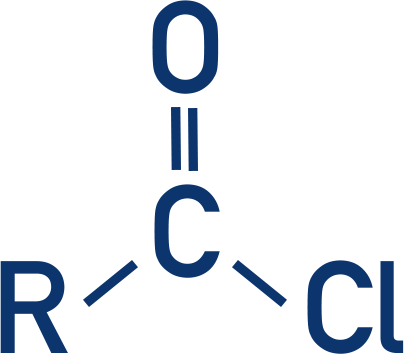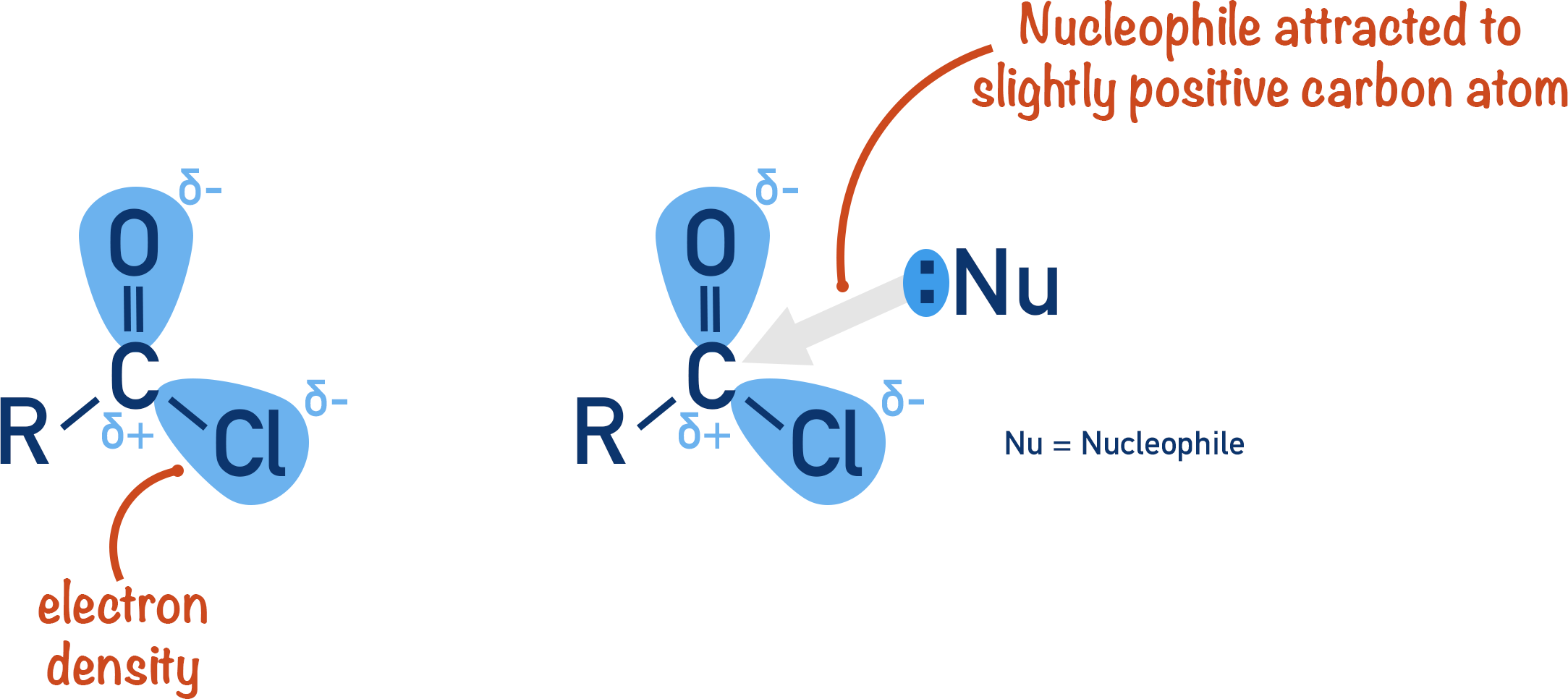Quick Notes Acyl Chlorides
- Acyl chlorides are highly reactive and easily react with nucleophiles. They have the functional group:

- They are prepared by reacting a carboxylic acid with phosphorus pentachloride (PCl5) in anhydrous conditions (acyl chlorides react easily with water).
- Acyl chlorides react with nucleophiles bonded to a hydrogen atom in addition-elimination reactions:

- Key reactions:
- Acyl Chloride + Water → Carboxylic Acid (+ HCl)
- Acyl Chloride + Alcohol → Ester (+ HCl)
- Acyl Chloride + Ammonia → Primary Amide (+ Ammonium Chloride)
- Acyl Chloride + Primary Amine → Secondary Amide (+ Alkyl Ammonium Chloride)
Full Notes Acyl Chlorides
The functional group of an acyl chloride contains a carbon with a double bond to an oxygen atom and a single bond to a chlorine atom.

Although the group looks very similar to a carboxylic acid, acyl chlorides are much more reactive than carboxylic acids. Their high reactivity is caused by the high electronegativities of both the oxygen and the chlorine atoms bonded to the carbon.

The oxygen and chlorine both pull electrons away from the carbon atom (electron withdrawing). This results in the carbon having a large ‘partial’ positive charge because it’s electron deficient. Nucleophiles easily react with the electron deficient carbon.
Making Acyl Chlorides
The high reactivity of acyl chlorides makes them very useful compounds in organic chemistry reactions, but it does mean they are difficult to work with.
Acyl chlorides will react with water in a vigorous reaction, making them hard (and dangerous) to store. So, acyl chlorides are made when required in a reaction using a carboxylic acid and phosphorus pentachloride (other reactants can be used).

The preparation of acyl chlorides must be carried out in anhydrous conditions (without water present).
Acyl Chloride Reactions – Nucleophilic Addition-Elimination

Acyl chlorides react with nucleophiles that have a hydrogen atom bonded to an atom with a lone pair of electrons. This is an example of a nucleophilic addition-elimination reaction, which occurs in a two-stage mechanism.
A nucleophile is attracted to the electron deficient carbon in the acyl chloride and donates electrons to it. This forms a bond between the carbon atom and the nucleophile. The atom that donated the electron pair now becomes positively charged. At the same time, the C=O double bond is forced to break, so the oxygen atom becomes a negative ion.

As a new group is being added to the carbon atom this part of the mechanism is described as addition.
Next, the oxygen ion reforms a double bond with the carbon atom and the carbon-chlorine bond breaks, releasing a chloride ion. The atom from the nucleophile, that now has a positive charge, breaks its bond with the hydrogen atom to become neutral. This releases a proton, which forms hydrogen chloride with the released chloride ion.

During this part of the mechanism the chlorine is being removed from the carbon atom, meaning it’s the elimination step of the mechanism.

The overall mechanism is described as nucleophilic addition-elimination.
Acyl Chloride Reactions:
Acyl Chloride and Water
In this reaction, water is added and a carboxylic acid is formed (as well as HCl).

Acyl Chloride and Alcohol
In this reaction, an ester is formed (as well as HCl)

Acyl Chloride and Ammonia
In this reaction, a primary amide and ammonium chloride is formed.

The ammonium salt formation is due to the ammonia present reacting with the HCl produced in the reaction. Ammonia is a base, so it accepts the proton that is eliminated from the intermediate in the reaction, forming an ammonium ion, NH+4.

This ammonium ion is attracted to the negative chloride ion that is eliminated from the acyl chloride, producing ammonium chloride. This is why ammonium chloride and not HCl is formed.
Acyl Chloride with (primary) Amine
In this reaction, a secondary amide and an alkyl-ammonium chloride salt is formed.

The alkyl-ammonium chloride salt forms in the same way as the ammonium chloride does in the reaction between an acyl chloride and ammonia.

The nitrogen in the amine accepts the proton eliminated during the reaction and forms a positive ion that is attracted to the chloride ion also eliminated in the reaction, forming an alkyl ammonium chloride salt. The alkyl part of the salt just comes from the carbon chain. For example, ethyl amine becomes ethyl ammonium chloride.
